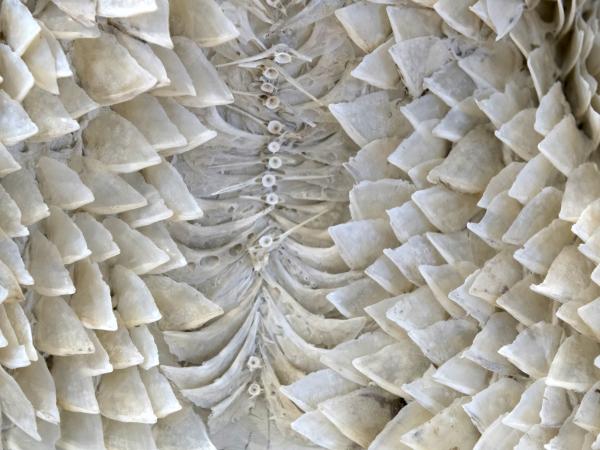MUSEUM EXHIBITION
The artist Fazal Sheikh has collaborated with writer Terry Tempest Williams on “Exposure,” which emerged in response to the recent decision to significantly reduce two National Monuments in Utah. One of these is Grand Staircase-Escalante, currently defined by the Great Basin’s boundary on its northern edge, a natural definition it may lose in order to enable resource extraction.
Photographer Emmet Gowin has made aerial photographs throughout the western U.S. that illuminate the human impact on the landscape. One body of photographs records the scarred and cratered landscapes of the Nevada Test Site, the site of more than 900 nuclear tests over more than four decades. Other images reveal the long-term effects of mining and other human activities on the surface of the Great Basin’s landscapes.
The exhibition also includes new work by painter Cedra Wood. The Center commissioned Wood to travel throughout the Great Basin and respond to it through her work, which investigates ecological concepts of belonging and survival through hyper-realistic imagery that often incorporates fantasy. Wood found inspiration for her new works at sites that reveal the extremes in topography and environment within the Great Basin.
Painter/printmaker Frances Ashforth contributes new work about the Great Basin watershed that draws on her deep interest in the human relationship to water. Her abstracted landscape images have a lyrical beauty that reflects her conservationist impulses. The exhibition contains monotypes made at two distinct sites in the Great Basin — the Ana River/Summer Lake area of Oregon and Bear River/Antelope Island in Utah.
Other work in the exhibition considers the Great Basin as a site of creative energy — a place where artists have been inspired and able to pursue projects they couldn’t realize elsewhere. Andrea Zittel was one of the founders of High Desert Test Sites near Joshua Tree, California, a place for artistic and cultural experimentation that has hosted projects by numerous artists. For Zittel, the southwestern corner of the Great Basin that is home to High Desert Test Sites has long been a source of artistic inspiration. The exhibition includes a large-scale painting by Zittel paired with one of her “Wall Sprawl” works — wallpaper generated from aerial photographs of urban, industrial and military development in the Great Basin’s deserts.
For Land Artists working in the 1970s, the Great Basin offered the opportunity to execute large-scale projects in remote landscapes relatively untouched by development. Vast open spaces and inexpensive real estate allowed Nancy Holt and Robert Smithson to create works outside (and far from) the traditional institutional structures of the art world. The exhibition includes Holt’s film “Sun Tunnels” and Smithson’s “Spiral Jetty,” both made during their work on their earthworks of the same name. Alongside these works are a series of related exhibition prints.
